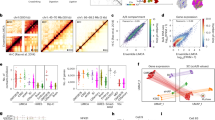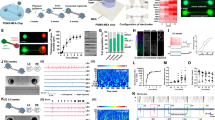Abstract
The c-fos gene (also known as Fos) is induced by a broad range of stimuli and is a reliable marker for neural activity. Here we demonstrate that multiple enhancers surrounding the c-fos gene are crucial for ensuring robust c-fos response to various stimuli. Membrane depolarization, brain-derived neurotrophic factor (BDNF) and forskolin activate distinct subsets of the enhancers to induce c-fos transcription in neurons, suggesting that stimulus-specific combinatorial activation of multiple enhancers underlies the broad inducibility of the c-fos gene. Accordingly, the functional requirement of key transcription factors varies depending on the type of stimulation. Combinatorial enhancer activation also occurs in the brain. Providing a comprehensive picture of the c-fos induction mechanism beyond the minimal promoter, our study should help in understanding the physiological nature of c-fos induction in relation to neural activity and plasticity.
This is a preview of subscription content, access via your institution
Access options
Subscribe to this journal
Receive 12 print issues and online access
$209.00 per year
only $17.42 per issue
Buy this article
- Purchase on Springer Link
- Instant access to full article PDF
Prices may be subject to local taxes which are calculated during checkout







Similar content being viewed by others
Change history
22 January 2016
In the version of this article initially published, it was stated that the c-fos gene-based TRAP mouse line described in ref. 42 utilized only the c-fos promoter region to drive CreERT2. In fact, that line was generated by CreERT2 knock-in to the endogenous c-fos locus. Accordingly, the sentence “Its induction mechanism and available reporter mouse lines are based exclusively on c-fos promoter activity” has been deleted from the Abstract, and the following sentences have been deleted from the third paragraph of the Discussion: “However, these mice utilize only the c-fos promoter region to induce the reporter fluorescent protein and do not include any of the c-fos enhancers we have characterized. On the basis of our findings, the promoter-only reporters might not faithfully recapitulate the expression characteristics of the endogenous c-fos gene in vivo triggered by sensory or pharmacological stimuli.” The changes have been made in the HTML and PDF versions of the article.
References
Lyons, M.R. & West, A.E. Mechanisms of specificity in neuronal activity-regulated gene transcription. Prog. Neurobiol. 94, 259–295 (2011).
Frey, U., Frey, S., Schollmeier, F. & Krug, M. Influence of actinomycin D, a RNA synthesis inhibitor, on long-term potentiation in rat hippocampal neurons in vivo and in vitro. J. Physiol. (Lond.) 490, 703–711 (1996).
Sheng, M. & Greenberg, M.E. The regulation and function of c-fos and other immediate early genes in the nervous system. Neuron 4, 477–485 (1990).
Bartel, D.P., Sheng, M., Lau, L.F. & Greenberg, M.E. Growth factors and membrane depolarization activate distinct programs of early response gene expression: dissociation of fos and jun induction. Genes Dev. 3, 304–313 (1989).
Heinz, S., Romanoski, C.E., Benner, C. & Glass, C.K. The selection and function of cell type-specific enhancers. Nat. Rev. Mol. Cell Biol. 16, 144–154 (2015).
Kim, T.K. et al. Widespread transcription at neuronal activity-regulated enhancers. Nature 465, 182–187 (2010).
Kim, T.K. & Shiekhattar, R. Architectural and Functional Commonalities between Enhancers and Promoters. Cell 162, 948–959 (2015).
Kaikkonen, M.U. et al. Remodeling of the enhancer landscape during macrophage activation is coupled to enhancer transcription. Mol. Cell 51, 310–325 (2013).
Dixon, J.R. et al. Topological domains in mammalian genomes identified by analysis of chromatin interactions. Nature 485, 376–380 (2012).
Sexton, T. et al. Three-dimensional folding and functional organization principles of the Drosophila genome. Cell 148, 458–472 (2012).
Jin, F. et al. A high-resolution map of the three-dimensional chromatin interactome in human cells. Nature 503, 290–294 (2013).
Sanyal, A., Lajoie, B.R., Jain, G. & Dekker, J. The long-range interaction landscape of gene promoters. Nature 489, 109–113 (2012).
Schwarzer, W. & Spitz, F. The architecture of gene expression: integrating dispersed cis-regulatory modules into coherent regulatory domains. Curr. Opin. Genet. Dev. 27, 74–82 (2014).
Flavell, S.W. & Greenberg, M.E. Signaling mechanisms linking neuronal activity to gene expression and plasticity of the nervous system. Annu. Rev. Neurosci. 31, 563–590 (2008).
Wu, H. et al. Tissue-specific RNA expression marks distant-acting developmental enhancers. PLoS Genet. 10, e1004610 (2014).
Andersson, R. et al. An atlas of active enhancers across human cell types and tissues. Nature 507, 455–461 (2014).
Nord, A.S. et al. Rapid and pervasive changes in genome-wide enhancer usage during mammalian development. Cell 155, 1521–1531 (2013).
Core, L.J. et al. Analysis of nascent RNA identifies a unified architecture of initiation regions at mammalian promoters and enhancers. Nat. Genet. 46, 1311–1320 (2014).
Pekowska, A. et al. H3K4 tri-methylation provides an epigenetic signature of active enhancers. EMBO J. 30, 4198–4210 (2011).
Koch, F. et al. Transcription initiation platforms and GTF recruitment at tissue-specific enhancers and promoters. Nat. Struct. Mol. Biol. 18, 956–963 (2011).
Schaukowitch, K. et al. Enhancer RNA facilitates NELF release from immediate early genes. Mol. Cell 56, 29–42 (2014).
Arner, E. et al. Gene regulation. Transcribed enhancers lead waves of coordinated transcription in transitioning mammalian cells. Science 347, 1010–1014 (2015).
Malik, A.N. et al. Genome-wide identification and characterization of functional neuronal activity-dependent enhancers. Nat. Neurosci. 17, 1330–1339 (2014).
Heintzman, N.D. et al. Histone modifications at human enhancers reflect global cell-type-specific gene expression. Nature 459, 108–112 (2009).
Dekker, J. The three 'C' s of chromosome conformation capture: controls, controls, controls. Nat. Methods 3, 17–21 (2006).
Thomas-Chollier, M. et al. RSAT 2011: regulatory sequence analysis tools. Nucleic Acids Res. 39 (suppl. 2), W86–W91 (2011).
Misra, R.P. et al. L-type voltage-sensitive calcium channel activation stimulates gene expression by a serum response factor-dependent pathway. J. Biol. Chem. 269, 25483–25493 (1994).
Ramamoorthi, K. et al. Npas4 regulates a transcriptional program in CA3 required for contextual memory formation. Science 334, 1669–1675 (2011).
Sheng, M., Dougan, S.T., McFadden, G. & Greenberg, M.E. Calcium and growth factor pathways of c-Fos transcriptional activation require distinct upstream regulatory sequences. Mol. Cell. Biol. 8, 2787–2796 (1988).
Lin, Y. et al. Activity-dependent regulation of inhibitory synapse development by Npas4. Nature 455, 1198–1204 (2008).
Gilbert, L.A. et al. CRISPR-mediated modular RNA-guided regulation of transcription in eukaryotes. Cell 154, 442–451 (2013).
Gilbert, L.A. et al. Genome-scale CRISPR-mediated control of gene repression and activation. Cell 159, 647–661 (2014).
Lagha, M., Bothma, J.P. & Levine, M. Mechanisms of transcriptional precision in animal development. Trends Genet. 28, 409–416 (2012).
Morgan, J.I., Cohen, D.R., Hempstead, J.L. & Curran, T. Mapping patterns of c-fos expression in the central nervous system after seizure. Science 237, 192–197 (1987).
Monteggia, L.M. et al. Essential role of brain-derived neurotrophic factor in adult hippocampal function. Proc. Natl. Acad. Sci. USA 101, 10827–10832 (2004).
Greenberg, M.E. & Ziff, E.B. Stimulation of 3T3 cells induces transcription of the c-fos proto-oncogene. Nature 311, 433–438 (1984).
Kawashima, T., Okuno, H. & Bito, H. A new era for functional labeling of neurons: activity-dependent promoters have come of age. Front. Neural Circuits 8, 37 (2014).
Fleischmann, A. et al. Impaired long-term memory and NR2A-type NMDA receptor-dependent synaptic plasticity in mice lacking c-Fos in the CNS. J. Neurosci. 23, 9116–9122 (2003).
Lamprecht, R. & Dudai, Y. Transient expression of c-Fos in rat amygdala during training is required for encoding conditioned taste aversion memory. Learn. Mem. 3, 31–41 (1996).
Mileusnic, R., Anokhin, K. & Rose, S.P. Antisense oligodeoxynucleotides to c-fos are amnestic for passive avoidance in the chick. Neuroreport 7, 1269–1272 (1996).
Barth, A.L., Gerkin, R.C. & Dean, K.L. Alteration of neuronal firing properties after in vivo experience in a fosGFP transgenic mouse. J. Neurosci. 24, 6466–6475 (2004).
Guenthner, C.J., Miyamichi, K., Yang, H.H., Heller, H.C. & Luo, L. Permanent genetic access to transiently active neurons via TRAP: targeted recombination in active populations. Neuron 78, 773–784 (2013).
Andrey, G. et al. A switch between topological domains underlies HoxD genes collinearity in mouse limbs. Science 340, 1234167 (2013).
Chipumuro, E. et al. CDK7 inhibition suppresses super-enhancer-linked oncogenic transcription in MYCN-driven cancer. Cell 159, 1126–1139 (2014).
Whyte, W.A. et al. Master transcription factors and mediator establish super-enhancers at key cell identity genes. Cell 153, 307–319 (2013).
Hnisz, D. et al. Convergence of developmental and oncogenic signaling pathways at transcriptional super-enhancers. Mol. Cell 58, 362–370 (2015).
Pinheiro, E.M. et al. Lpd depletion reveals that SRF specifies radial versus tangential migration of pyramidal neurons. Nat. Cell Biol. 13, 989–995 (2011).
Rexach, J.E. et al. Dynamic O-GlcNAc modification regulates CREB-mediated gene expression and memory formation. Nat. Chem. Biol. 8, 253–261 (2012).
Flavell, S.W. et al. Activity-dependent regulation of MEF2 transcription factors suppresses excitatory synapse number. Science 311, 1008–1012 (2006).
Pereira, A.H. et al. MEF2C silencing attenuates load-induced left ventricular hypertrophy by modulating mTOR/S6K pathway in mice. PLoS ONE 4, e8472 (2009).
Heigwer, F., Kerr, G. & Boutros, M. E-CRISP: fast CRISPR target site identification. Nat. Methods 11, 122–123 (2014).
Sanjana, N.E., Shalem, O. & Zhang, F. Improved vectors and genome-wide libraries for CRISPR screening. Nat. Methods 11, 783–784 (2014).
Flavell, S.W. et al. Genome-wide analysis of MEF2 transcriptional program reveals synaptic target genes and neuronal activity-dependent polyadenylation site selection. Neuron 60, 1022–1038 (2008).
Acknowledgements
We thank L. Monteggia and members of her laboratory for providing conditional Bdnf KO mice. We thank M. Greenberg for providing MEF2A and MEF2D antibodies used for ChIP experiments. We also thank W. Xu for advice on stereotaxic injection, and C. Green and J. Stubblefield for providing the dark controlled-environment chamber. This work was supported by the US National Science Foundation (NSF) BRAIN EAGER Award (IOS1451034) and the US National Institute of Neurological Disorders and Stroke (NINDS) under award number R01NS085418 (T.-K.K.).
Author information
Authors and Affiliations
Contributions
T.-K.K. and J.-Y.J. designed the project; J.-Y.J. performed CRISPRi, 3C assays, luciferase reporter assay, ChIP, immunocytochemistry, in vivo experiments, in vitro analysis of transcription factor knockdown and eRNA and mRNA expression analysis. K.S. performed western blot and expression analysis for c-fos eRNA in NIH 3T3 cells. L.F. performed primary cortical neuron culture, helped to make lentivirus constructs and helped in CRISPRi and shRNA cloning. G.K. performed bioinformatics analysis. J.-Y.J., K.S. and T.-K.K. wrote the manuscript. All authors discussed the results and commented on the manuscript.
Corresponding author
Ethics declarations
Competing interests
The authors declare no competing financial interests.
Supplementary information
Supplementary Text and Figures
Supplementary Figures 1–16 (PDF 31075 kb)
Rights and permissions
About this article
Cite this article
Joo, JY., Schaukowitch, K., Farbiak, L. et al. Stimulus-specific combinatorial functionality of neuronal c-fos enhancers. Nat Neurosci 19, 75–83 (2016). https://doi.org/10.1038/nn.4170
Received:
Accepted:
Published:
Issue Date:
DOI: https://doi.org/10.1038/nn.4170
This article is cited by
-
The locus coeruleus input to the rostral ventromedial medulla mediates stress-induced colorectal visceral pain
Acta Neuropathologica Communications (2023)
-
Divergent projections of the prelimbic cortex mediate autism- and anxiety-like behaviors
Molecular Psychiatry (2023)
-
Remembering through the genome: the role of chromatin states in brain functions and diseases
Translational Psychiatry (2023)
-
Recording of cellular physiological histories along optically readable self-assembling protein chains
Nature Biotechnology (2023)
-
Differential expression of Dusp1 and immediate early response genes in the hippocampus of rats, subjected to forced swim test
Scientific Reports (2023)



